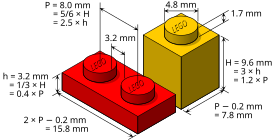Lego is a popular line of construction toys manufactured by The Lego Group, a privately held company based in Billund, Denmark. The company's flagship product, Lego, consists of colourful interlocking plastic bricks and an accompanying array of gears, minifigures and various other parts. Lego bricks can be assembled and connected in many ways, to construct such objects as vehicles, buildings, and even working robots. Anything constructed can then be taken apart again, and the pieces used to make other objects.
Lego began manufacturing interlocking toy bricks in 1949. Since then a global Lego subculture has developed, supporting movies, games, competitions, and six themed amusement parks. As of 2013, around 560 billion Lego parts had been produced.
Lego pieces of all varieties constitute a universal system. Despite variation in the design and purpose of individual pieces over the years, each remains compatible in some way with existing pieces. Lego bricks from 1958 still interlock with those made in the current time, and Lego sets for young children are compatible with those made for teenagers.
Each Lego piece must be manufactured to an exacting degree of precision. When two pieces are engaged they must fit firmly, yet be easily disassembled. The machines that make Lego bricks have tolerances as small as 2 micrometres.
Primary concept and development work takes place at the Billund headquarters, where the company employs approximately 120 designers. The company also has smaller design offices in the UK, Spain, Germany, and Japan, which are tasked with developing products aimed specifically at these markets. The average development period for a new product is around twelve months, in three stages. The first stage is to identify market trends and developments, including contact by the designers directly with the market; some are stationed in toy shops close to holiday periods, while others interview children. The second stage is the design and development of the product based upon the results of the first stage. As of September 2008 the design teams use 3D modellingsoftware to generate CAD drawings from initial design sketches. The designs are then prototyped using an in-house stereolithography machine. These are presented to the entire project team for comment and for testing by parents and children during the "validation" process. Designs may then be altered in accordance with the results from the focus groups. Virtual models of completed Lego products are built concurrently with the writing of the user instructions. Completed CAD models are also used in the wider organisation, such as for marketing and packaging.
Manufacture
Since 1963, Lego pieces have been manufactured from a strong, resilient plastic known as acrylonitrile butadiene styrene (ABS). As of September 2008, the engineers use the NXCAD/CAM/CAE PLM software suite to model the elements. The software allows the parts to be optimised by way of mould flow and stress analysis. Prototype moulds are sometimes built before the design is committed to mass production. The ABS plastic is heated to 232 °C (450 °F) until at a dough-like consistency. It is then injected into the moulds at pressures between 25 and 150 tons, and takes approximately 15 seconds to cool. The moulds are permitted a tolerance of up to two micrometres, to ensure the bricks remain connected.Human inspectors check the output of the moulds, to eliminate significant variations in colour or thickness. According to the Lego Group, about eighteen bricks out of every million fail to meet the standard required.Lego factories recycle all but about 1 percent of their plastic waste from the manufacturing process. If the plastic cannot be re-used in Lego bricks, it is processed and sold on to industries that can make use of it.
Manufacturing of Lego bricks occurs at a number of locations around the world. Moulding is done in Billund, Denmark; Nyíregyháza, Hungary; and Monterrey, Mexico. Brick decorations and packaging is done at plants in Denmark, Hungary, Mexico and Kladno in the Czech Republic. The Lego Group estimates that in the course of five decades it has produced some 400 billion Lego blocks. Annual production of Lego bricks averages approximately 36 billion per year, or about 1140 elements per second. If all the Lego bricks ever produced were to be divided equally among a world population of six billion, each person would have 62 Lego bricks. According to an article in BusinessWeek in 2006, Lego could be considered the world's No. 1 tire manufacturer; the factory produces about 306 million small rubber tires a year.
In December 2012, the BBC's More or Less programme asked the Open University's engineering department to determine "how many Lego bricks, stacked one on top of the other, it would take to destroy the bottom brick?"Using a hydraulic testing machine, the engineering department determined the average maximum force a 2×2 Lego brick can stand is 4,240 newtons; since an average 2×2 Lego brick has a mass of 1.152 grams (0.0406 oz), according to their calculations it would take a stack of 375,000 bricks to cause the bottom brick to collapse, which represents a stack 3,591 metres (11,781 ft) in height
CLICK THIS BANNER LINKS TO VISIT THE SITES


















No comments:
Post a Comment